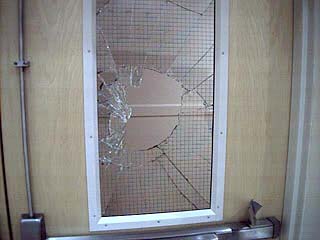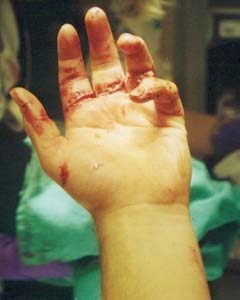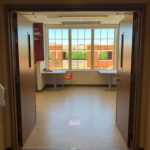This is the second post in a series about the hazards of traditional wired glass (read the first post here).
I was recently in the warehouse of a local door and hardware supplier, and I saw stacks of wired glass for various sizes of glass lites in fire doors. None of this glass was marked with an etching or label stating that it was impact-resistant. There was also a small stack of a clear product – no wires – that can be used in fire doors and is also impact-resistant but has a higher cost. I asked the supplier about the glass they are typically supplying, and he said that most contractors and end users don’t want to pay for the “wireless” glass.
REALLY?!? In the vast majority of the country, the current codes do not allow traditional wired glass to be installed in doors or sidelites in schools, and in most states it is not allowed in these locations in any occupancy type (more about the code changes in an upcoming post). It’s not a question of whether someone wants to pay extra for the impact-resistant glass – it’s required by code! The potential liability of supplying and installing glass that is not impact-resistant is HUGE! There are well over 2,000 injuries each year due to broken wired glass – just in schools! If the concern for public safety isn’t enough, maybe the millions of dollars in lawsuits will get people’s attention.
- If you’re a supplier of doors and hardware, do you stock code-compliant glass products and teach your customers about the hazards of using traditional wired glass?
- If you’re responsible for the maintenance of a facility, have you evaluated the traditional wired glass in your building and prioritized its replacement?
- If you’re an architect or specifier, are you specifying impact-resistant glass to remove the temptation of choosing low cost over safety and code-compliance?
- If you’re a contractor, are you verifying that the glass on your projects is impact-resistant?
- If you’re a fire marshal or building inspector, are you enforcing the current codes and advising facilities on recommendations for replacing the hazardous product?
- If you’re a parent, grandparent, aunt, uncle, neighbor or friend of a child or young adult, are you teaching them about the dangers of wired glass and talking to the facilities where they spend their time?
What are the risks if you don’t do your part? Are you willing to accept the liability? In case you need more convincing…here’s a little light reading.

Greg Abel’s son, Jarred, put his arm through this wired glass panel in 2001 while exiting a gym at the University of Oregon.
Shattering the Myth of Wired Glass
The common misperception is that the embedded wires reinforce impact strength, when they do just the opposite. The wires actually weaken the glass and substantially reduce its impact resistance, so wired glass is in fact only half as strong as ordinary annealed glass. Wired glass is more dangerous than regular glass when it breaks because the exposed wires are razor sharp and catch a victim’s body part in the opening, and increase the severity of the injury.
Children and young adults are seriously and permanently injured every year as a result of the dangerous use of wired glass vision panels in areas where impact safety glazing is required. Wired glass is commonly used in hospitals, schools and colleges as an approved fire-protection glazing for fire doors and windows installed in corridors, stairwells, gymnasium walls and other fire-rated areas where accidental human impact is likely.
The Hidden Danger of Wire Glass in our Schools
The schools should take appropriate measures in the best interests of our children, and dealing with the dangers posed by Wire glass head on should be a priority. The schools can and should educate and inform students and parents of the potential risks of contact with Wire glass. They should start with announcements over the PA system, have homeroom teachers discuss the issue, send home advisories to parents, hold student assembly meetings, post signs on the wall next to the glass or even on the glass. They should be taking these steps as they steadily move to modify or remove the existing Wire glass in the areas that our children have the most daily exposure to. A plan should be established for each school for the eventual protection or removal of all Wire glass.

Jarred Abel severed nerves and tendons in his hand and upper arm. After surgery, he spent several months in physical therapy and has permanent damage.
There is absolutely no excuse for our schools to look the other way on this issue knowing the dangers involved. The schools have an obligation to avoid even one life altering injury to a student. We all need to bring this issue to the attention of our schools and School Boards to ensure the safety of our children.
Wire Glass Advisory – New York State Dept. of Education
New York State will soon adopt this provision and new installations of glazing in hazardous locations in schools will be required to be impact resistant. There are several fire-rated and impact resistant glazing options available today and school districts and architects should research the advantages and disadvantages of all options. Wire glass will not be an available option.
Now for the difficult part, what do we do with existing wire glass installations? We strongly recommend that all existing wire glass locations be evaluated for potential impact and injury. There are several alternatives available to remedy locations determined to be at risk, such as replacement with impact and fire resistant materials, coating the glass with specialty films and installing protective bars or railings.
Making Unsafe Wired Glass Installations Safe
Traditional wired glass is not safety glass. The wire actually weakens the glass and increases the likelihood of breakage, even under the relatively mild force exerted by an elementary school student. According to an Emory University professor, there are well over 2,000 injuries every year associated with wired glass in schools.
Ontario School Board’s Insurance Exchange
OSBIE receives many reports of incidents and notices of claims with respect to injuries received by students seriously cut through impact with glass. Many of these injuries are cause by wired safety glass in schools. From 1987 to 2000 there have been 107 claims against schools for glass injuries. Over this period, costs related to glass injuries amounted to $3,154,202.00. More important than the dollars is the pain and suffering, permanent reduced mobility and scarring caused by these impacts with glass.
Replacing Unsafe Wired Glass Reduces Liability
In December 2003, Oregon’s state schools chief Susan Castillo sent out a memo alerting all superintendents that “documented instances of students being injured as a result of collisions with wire glass both here in Oregon and around the country.” According to a recent Multnomah County court case, the Portland school district doesn’t remember receiving this warning memo. The court found the school district to be negligent for a 2007 middle-school accident in which 13 year old Shakiya Sargent’s right leg pierced through the lower pane of wired glass on a fire door separating the cafeteria and the hallway. The jury verdict requires the school district to pay Sargent $222,000 in damages.
Oregon Jury Awards Injured Victim of Wire Glass Accident
According to the complaint the accident occurred when Sargent was late for art class and, with her arms loaded with books, kicked the heavy door open with her right foot. As the complaint alleges, “the glass in the door was wired glass, designed not to shatter upon contact.” It also alleges that the defendant, PPS, was “warned by the superintendent of Public Instruction about documented serious injuries to students as a result of collisions with wired glass.”
The complaint reads that “the defendant knew that students foreseeably run in school hallways; and that wired glass in a doorway located in a high traffic and spill intensive area between the cafeteria and adjacent gymnasium, outdoor exit and classroom, causing students to be subjected to an unreasonably greater risk of severe injury.”
Photos courtesy of Advocates for Safe Glass.
You need to login or register to bookmark/favorite this content.





As Technical Director for the National and Americas Glass Associations since 1978, I have long opposed the use of wired glass in hazardous locations. I testified against the use of wired glass before ther early formation of safety glazing regulations by the CPSC in the early 1990s.
Until Greg Abel took active participation with “Advocates for Safe Glass” little progress was achieved with the “Model Code” groups and later with IBC. I had written numerous national articles on the on the fact that wired glass was not safety glass and published a safety glazing codes interpretation, tri-annual manual for UBC and IBC since 1980 called “the Source.”
I was amember of the ANSI Z97.1 committe for 8 years at no avail to stop them from recognizing wired glass as a saftey glazing material The wired glass manufacturers were too powerful.
I disagree with the present code exceptions that do not require safety glazing in certain locations. There should be no exceptions.
Hi Donn –
I’m sure your work opened some eyes and I know it was a tough fight. Is “The Source” available as a PDF? Thank you for your role in making buildings safer!
– Lori
Hi Lori,
The most current “Source” is 2009 and it is available in PDF format.
For more information contact: info@glasspublications.com
Thanks, Donn
Thanks Donn!
Lori…
Thanks for educating us on the dangers of wired glass.
Lori….
From a hospital/nursing home point of view, the 2012 edition of the NFPA 101 Life Safety Code for new construction did change to no longer permit wired glass panels in vision panels for doors in smoke compartment barriers. However, they still allow wired glass panels or fire-rated glazing in cross-corridor swinging doors in smoke compartment barriers.
So, there are lots of healthcare facilities out there with wired glass panels.
Thanks Brad. After I finish explaining the IBC requirements I’ll do a post on 101.
I made my own presentation for in-house training on the dangers of wired glass and where exactly it is still allowed to be used. It is a little dated, and I included a few (somewhat snarky) items including a “home made” glass break test I found online because I thought it was funny. Feel free to take a look:
http://prezi.com/edcvqxhack0z/wired-glass/?auth_key=6b1823ebfb41c19fb450bce1494ddbe6bf8200d4